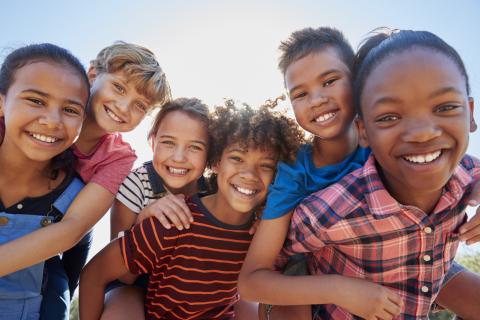
Education Buzzwords: A Rundown on Social Emotional Learning
Education Buzzwords: A Rundown on Social & Emotional Learning
Although the concept has been around for some time, social emotional learning (SEL) has become the new buzzword in education circles, joining the ranks of other child and youth-centered keywords including trauma-informed teaching, restorative justice, and positive behavior intervention schools. Each strategy in its own right is an attempt to center the whole child, and builds emotional intelligence in a school climate that has shifted over the years to focus on high stakes testing. A trauma-informed pedagogical model for instance includes an emphasis on understanding that children are exposed to trauma on a regular basis that can have an impact on the way a student is able to be present and learn in school. This approach encourages a deep dive into the root cause of a student's behavior and a support systems approach to addressing the trauma as a barrier to student potential and success. Examples of trauma-informed efforts more broadly include pushes to reduce the number of cops in schools and instead increase the number of counselors available in their place. Restorative justice education approaches similarly seeks to position students and their peers to be proactive in harm reduction within schools and often includes practices such as peer mediation and accountability circles.
What is Social Emotional (SEL) Learning?
Social emotional learning, according to the Collaborative for Academic, Social, and Emotional Learning (CASEL), is the process through which children and adults acquire and effectively apply the knowledge, attitudes, and skills necessary to understand and manage emotions, set and achieve positive goals, feel and show empathy for others, establish and maintain positive relationships, and make responsible decisions. A major component to effective SEL efforts in schools is the collaborative learning that takes place between the teacher and the students. This approach, unlike restorative justice efforts and trauma-informed efforts, situates the learning as an exchange between the teacher and student with the student functioning as a sort of teacher as well. This exploratory learning relationship allows for deeper trust and collaboration to take place within the classroom. CASEL identifies five core competencies that are taught as part of a framework for systemic social and emotional learning: 1) self awareness, 2) self management, 3) social awareness, 4) relationship skills, and 5) responsible decision-making. These are also critical components to building strong relationships, tolerance, trust, and collaboration. Trust and relationship-building are also strong practices for reducing implicit bias and racial trauma—what the Equal Justice Society identified in their Breaking the Chains report as fuel for the school-to-prison pipeline. In fact, implicit bias, coupled with arbitrary and exclusionary school discipline policies, teacher discretion, police presence in schools, and a disproportionate racial impact are the bolts that keep the pipeline together.
Why Social Emotional Learning Can Disrupt the School-to-Prison Pipeline
It is no coincidence that the increased rate nationwide in student suspensions and police presence in schools dovetails with the war on drugs, poverty, and the subsequent increase in mass incarceration. The rampant criminalization of black and brown communities is mirrored in schools as microcosms of society at large. Both teachers and students bring their aspirational intentions, trauma, and biases to the classroom. Still, much of the education reform debate has centered on charter versus public schools and high stakes testing, leaving out critical indicators for student success reflected in schools that use an integrated social emotional learning curriculum. Having social emotional learning as additional programs rather than integrated into the fabric of the school culture and academics is just not enough. The Aspen Institute’s National Commission on Social, Emotional, and Academic Development recently published a report called Putting it All Together. The report highlights promising examples of schools and organizations across the country that are shifting school culture by integrating social, emotional, and academic development to support student development in and out of school. These programs seek to develop students’ skills that fall within traditional academic curriculum and assessment and those that do not. This includes skills such as critical thinking and problem solving, effective communication and collaboration, conflict resolution, and developing an appreciation for lifelong learning. Being social shapes students’ behavior and habits: From early on students learn from their peers in informal ways that get lost as they enter the K-12 space. The report cites a growing body of research that draws on brain science and child development that recognize integrated social emotional and academic learning as consistent with how the brain takes in and processes information.
The Future of Social Emotional Learning
Examples of school districts and education organization that are embracing this type of curriculum and shift in learning include the San Francisco Unified School District and Facing History and Ourselves, a non profit that explores racism, prejudice and religious intolerance with students, and the Center for the Collaborative Classroom whose mission affirms the approach “how we teach matters as much as what we teach.”
These examples model a necessary shift in our approach to education and the importance of developing young people so they can contribute meaningfully in the societies of our future. Coupled with other efforts including trauma-informed and restorative justice teaching, social emotional learning tools can be a powerful force in dismantling the school-to-prison pipeline and building the cradle to college pipeline. We must adopt positive interventions and institute supportive approaches that include SEL, trauma-informed, and restorative justice practices. Doing so strengthens student-teacher relationships and trust, while building an inclusive and equitable school climate conducive to student success. To do this, it is critical to push school districts to provide teachers with support and training, including training in implicit bias, SEL and trauma-informed strategies. Lastly, we must challenge archaic policies that criminalize kids, including zero-tolerance policies and exclusionary school discipline. Kids have to be in schools for these efforts to work. Suspension, expulsions and zero tolerance policies have since their inception disproportionately impacted students of color and disabled students—and in the long run do irreparable harm to kids and society as a whole.
The school to prison pipeline was built over years through policies and practices that reinforce negative stereotypes and cause trauma and harm. It is going to take all the tools on the table to dismantle it and build something better. SEL is an important piece in this conversation, and powerful lever for parents and students. As parents, teachers, students, and community members, we must push towards a fundamental shift in discipline, learning, and development in our schools. Rather than perpetuating a culture of criminalizing children and youth.


The views and opinions expressed in this post are those of the author(s) and do not necessarily reflect those of MomsRising.org.
MomsRising.org strongly encourages our readers to post comments in response to blog posts. We value diversity of opinions and perspectives. Our goals for this space are to be educational, thought-provoking, and respectful. So we actively moderate comments and we reserve the right to edit or remove comments that undermine these goals. Thanks!